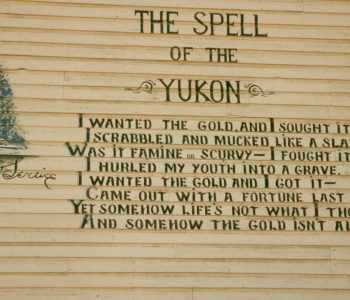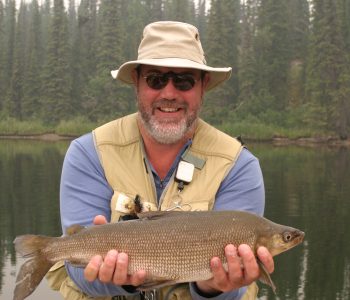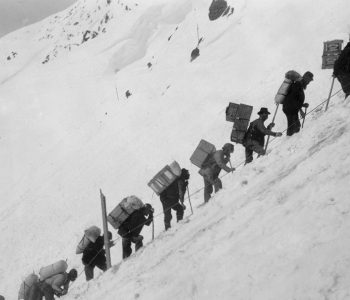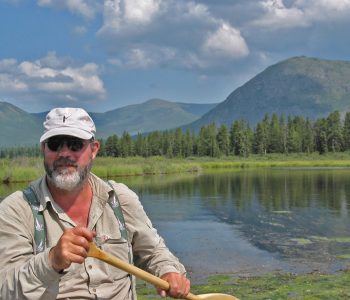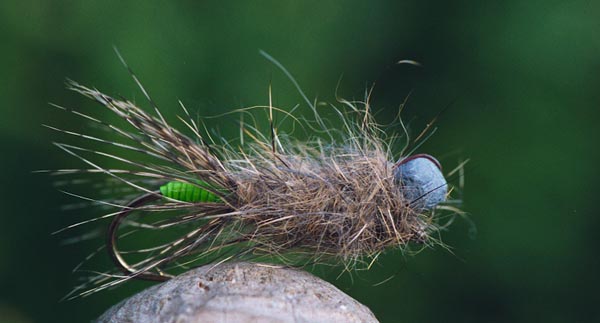
Nymphing for salmon in the newfie drought of 1999
It’s not strange for me to use nymphs for salmon fishing and I have caught quite a good number of fish with them. I learned this trick by accident in the year 1983 at one particular river when I was fishing for grayling. It was one of the few rivers in Norway in which grayling and salmon live together. At first I couldn’t believe it myself but it widens my skill and experience even more and opened a complete new dimension in my salmon fishing too. Of course I prefer dry fly fishing but when nothing works don’t hesitate to use a tiny little nymph for salmon. As I amazed most locals and guides by using really big wet flies for salmon in previous years, this extremely strange fishing year I amazed them even more by using tiny little nymphs and landing several salmon. I know how well nymphing for salmon works but you don’t use it very much. The best catches on a nymph I have had were in 1989 when I hooked and released 8 grilse in just one single day. That’s not bad is it? The last time I used nymphs for salmon was in 1994 so that was quite some years ago. I use nymphs mostly when results stay out or when waters are extremely low or just coming up quickly. In my opinion this is the two best situations for nymph fishing for salmon anyway with some big accent on low water. My own variation of the Montana nymph was my favourite for a rather long time until I designed some funny fancies that seems to work even better. It was nice to experiment with nymphs but unfortunately I never caught a real salmon and don’t know why. For a long time I had my doubts if it would be possible until a good friend of mine landed a 14lbs Norwegian salmon on a size 14 Remerger nymph. Norway has no restrictions for weighted patterns, maybe because many of the rivers are very deep and when the fish stay deep you have to grab a weighted fly to archive some success. European salmon don’t come up so easily as the salmon in North America and I could never find any reason why but it leads you to think clearly and develop( different techniques.
During my experience with nymphing for salmon I have built up some very nice techniques too. When I hooked my first ever by nymph it was with the Brooks technique, which I use a lot while nymphing for grayling. It’s a very effective technique when the current is strong and you want to present the fly deep but when I used it for salmon and more and more people took it over I just wanted to do something different. I don’t like it when flies are floating too often in the same way over a good lie. So when the catches got down the time came that I got very experimental again and I found some different useful techniques. Unfortunately most techniques I discovered were based on weighted patterns and with restrictions for using them in Newfoundland I never could use them or used them. A pity when you fish catch and release anyway and handle the fish in a very decent way! I know for sure that those techniques would work excellently in the extremely drought conditions of the strange Newfoundland summer of 1999 but with the restriction of weighted flies I had to search for some good alternatives. The water levels were lower then ever before and that needed complete other fishing techniques too.
The idea to start using nymphs for salmon in Newfoundland arose when I fished the Salmon River while we stayed at Barb Genge place for several days. I knew this place and the river from previous years and it is always nice to be hosted by Barb and her guides. Most rivers in the south were still closed and when one of the lodge owners let us down after a well planned visit our schedule was mixed up completely. Barb knew exactly how we felt and pepped us up by offering us some very nice alternates.
But even in Mainbrook the fishing was hard. There were plenty of fish in the river but the extreme hot weather and warm water temperature were our biggest enemies. Using wet flies was useless which we already discovered by experience a few days before when I fished the same river guided by Lewis Alcock. When dry fly fishing also became extremely poor I punished my mind hard to find a solution. Its not that I can’t stand it when catches are poor or stay out, its more the kick to catch one when everybody failed or told me that the fishing will be useless. Don’t forget we were fishing with air temperatures over 30 degrees Celsius and the sky more blue then steel. There were no other fishermen as crazy as we were but therefore we had the river to ourselves and that is an unbelievable feeling. After several hours without any success we finally reached a good pool in which plenty of fish had found their lies and they were even jumping and rolled well too. But even here it seemed impossible to hook any and our guide didn’t know what to do either. I think a lot of people can’t understand us but if you are fishing wild places and salmon are leaping everywhere it is very enjoyable. When I had my lunch and started reading the river more carefully I discovered that at several places the current was rather slow almost dead and when some fish rolled at the edge of the current it came in my mind to try to awake some activity or attention by using some small unweighted nymphs. I never tried it before in Atlantic Canada so the challenge was born. I could use the dead water to let the nymph sink well under the surface and when I could move it with very slow retrieving it maybe could work. It’s a technique that is extremely popular for catching whitefish by fly and if you know that I use my grayling techniques to hook salmon by dry fly why this couldn’t work either. I prepared a new leader and tie on a 4lbs almost 2 meters long tippet instead of the normal 6lb. I believed any trick to present the nymph as deep as possible under the surface could improve my chances.
The first nymph I tried was a Norwegian killer named the Toddler but that didn’t seem to work. Then I went back to a classic one called the Remerger, which I took from Ina’s fly box. The Remerger is a special fly and although it was at first designed for fun I think differently about its dressing today. There are unweighed nymphs, flymphs and emergers but because I think this pattern has all these properties built into it I give it the striking name of the REMERGER.
When my equipment was ready I gave it another try and at first it didn’t look very hopeful so I started to experiment by giving the nymph more time to get down and started to use the old Brooks method since a very long time. Maybe a dozen of casts later I hooked a fish and it felt like a big one too. I was afraid I fault hooked it but I also had my doubts because the retreivement was too slow and I didn’t strike or set the hook either. No it was hooked properly and it was a big salmon and it gave me a really good fight. About 20 minutes later the same happened again and again it was a salmon and another one landed and released before an hour was finished. In just 2 hours I had caught the day limit and all were salmon and if no-one had seen it you probably would not believe it.
The next day I hooked 2 grilse and another salmon all by the same technique but this time another nymph and there were even several eye witnesses around. I guess they heard about my success and suddenly more people went fishing. After that success we went to the Cloud River for a few days and stayed at the Pinnacle lodge. The prospects for fishing were really poor but we enjoyed the nature and wildlife very much but that will be another very nice story with another once of a lifetime experience when we played with a big sunfish for more then a hour. I hooked some very nice trout (char) in Cloud River when the sun faded away in a tangle of colours.
The next time the nymphs did all the damage again was when we visited our friends in central Newfoundland. It was our last week and even here the fishing looked worse then all the other places before. It was here where I got even further lost in the fishing rules which I couldn’t understand anymore. The beautiful class 1 river Great Rattling brook flowing in front of the lodge was closed and we only could fish some parts of the Exploits. The North Gander River with no water in it at all was still open and it all confused me too much to think about it. It surely was a hard year for all tourists and guests.
For me the Exploits is a big river and not easy to fish. There are not so many places where you can wade and have a good access but our host and guide Gord Robinson found a marvellous solution to bring us by boat to a huge rock formation that almost reached the middle of the river. For the 1999 season this was the absolute hotspot of the season and here we fished 4 days on row. Here I got my biggest salmon and again by unweighted nymphs on a size 14 hook.
THE DRESSINGS of my 4 favourites salmon nymphs during the 1999 season:
THE REMERGER
Hook : Daiichi 1760 size 14 -6
Tail : Partidge fibres dyed olive
Ribbing : Fine gold or copper wire (only rear section)
Body : 1/3 Hare’s ear plus no 2 natural colour (rear)
1/3 Olive brown hare-tron no 24 (centre)
Thorax :1/3 Grey hare-tron no 3 (front)
Wingcase : Heron herls dyed olive
Legs : Starling body feather or dyed olive partridge body feather tied under the wingcase
Front hackle: Starling body feather
Step by step TYING TECHNIQUE REMERGER
(will open in new window)
Another but more simpler nymph that worked great is a nameless pattern I find in box
This is the Dressing of my second pattern (unfortunately no name for this pattern):
Hook :Daiichi 1760 size 14 -6
Tail : Partidge fibres natural
Ribbing : Fine gold or copper wire
Body : 1/2 Hare’s ear natural greyish colour (rear)
1/4 Light ginger mixex with orange dubbing (centre)
Thorax :1/3 hare’s ear natural greyish colour (front)
Wing case : Peacock herl
Legs : Partridge body feather tied under the wingcase
The third nymph that is worthwhile to explain is called The Grey Buster:
Hook :Daiichi 1760 size 14 -6
Tail : Light coloured Partridge fibres
Ribbing : Fine gold or copper wire (only rear section)
Body : heron herl
Thorax : light olive dubbing
Wing case : Heron herls
Legs : Light coloured partridge hackle
Finally the last pattern that did a lot of damage this pattern is called the BWO nymph
Hook :Daiichi 1760 size 14 -6
Tail : Partridge fibres
Ribbing : Fine gold or copper wire (only rear section)
Body en thorax : rusty brown dubbing
Wingcase : split wing wingcase of any black herls
Head : orange
